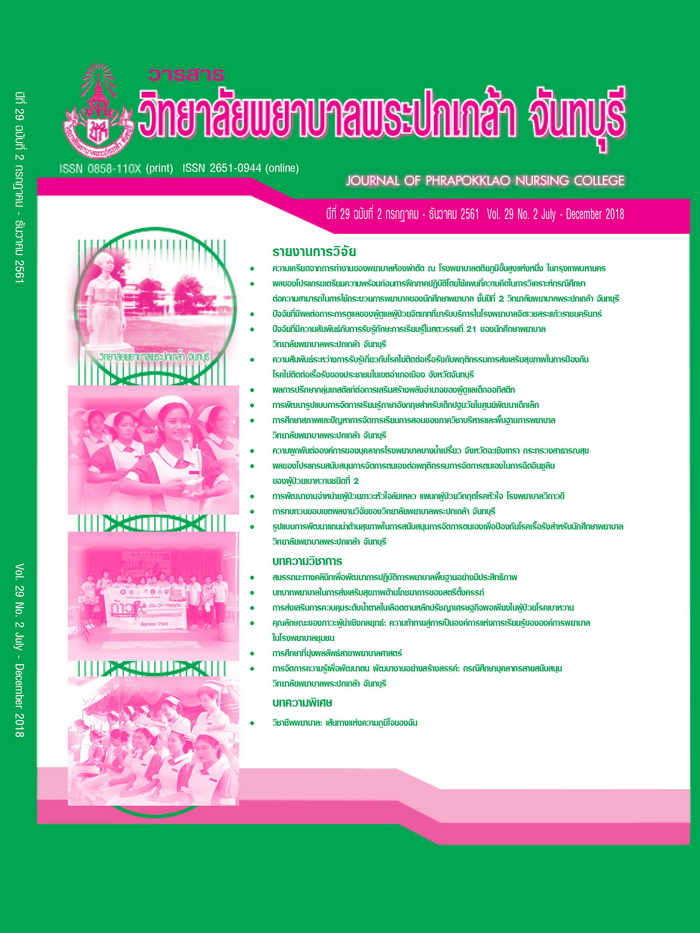Clinical Competency to Effectively Enhance Fundamental Nursing Practice
Keywords:
Clinical competency, Fundamental nursingAbstract
Fundamental nursing practice requires a nursing process in every activity. This is based on the clinical performance derived from knowledge, skills, capacity, and judgment. The skills needed to develop clinical competency in fundamental nursing practice are composed of management, coordination, innovation, communication, advocacy, systematic thinking, health teaching, problem-based learning, health promotion, and leadership. Apart, management consists of planning, event ranking, team organization, facilitating, job control, and reporting. Work collaboration is responsible for team building, pointing out benefits, and finding ways to collaborate together. Innovation in particular can be enhanced by refining, improved experiments, and practical new services. In communication, it consisted of selecting massages to convey, deep listening, observing changes, and message repetition along with the protection of patients’ rights, within acceptable values and patient safety, think systematically, teamwork, and use of empirical evidence. Health education is done on a step-by-step approach from pre-assessment, planning, teaching, and evaluation, respectively. Problem-based learning begins with problem analysis, followed by solution identification, and evaluation selected nursing methods. In the promotion of patients’ health, essential information was provided, empowerment, and proper coordination as the benefit. Leadership development is undertaken by utilizing proficient nursing process, thinking and communication, speaking, writing, and explanation skills. Periodic review of these competencies can help in the promotion of quality basic nursing practice and ensure the safety of clients.
References
จินตนา พรสัมฤทธิ์โชค, รวมพร มินานนท์, และชญานิศา เขมทัศน์. (2560). ผลการพัฒนาภาวะผู้นําต่อการมีภาวะผู้นําของนักศึกษาพยาบาลในรายวิชาปฏิบัติการบริหารการพยาบาล วิทยาลัยพยาบาลบรมราชชนนี เชียงใหม่. วารสารวิทยาลัยพยาบาลพระปกเกล้า จันทบุรี, 28(2), 55-66.
พิชญากร ศรีปะโค. (2557). การพัฒนาวิชาชีพพยาบาล: การพัฒนาภาวะผู้นำทางการพยาบาล. วารสารพยาบาลทหารบก, 15(3), 1-8.
สภาการพยาบาล. (2553). แนวทางการพัฒนาหลักสูตรตามมาตรฐานคุณวุฒิระดับปริญญาตรี สาขาพยาบาลศาสตร์. นนทบุรี: ผู้แต่ง.
Berry, L. L., & Parasuraman, A. (1997). Listening to the customer–the concept of a service-quality information system. Sloan Management Review, 38(3), 65-76.
Betcher, D. K. (2010). Elephant in the room project: Improving caring efficacy through effective and compassionate communication with palliative care patients. Medsurg Nursing, 19(2), 101-105.
Bittner, N. P., & Gravlin, G. (2009). Critical thinking, delegation, and missed care in nursing practice. Journal of Nursing Administration, 39(3 March), 142-146.
Bridges, E. M. (1992). Problem based learning for administrators. Retrieved from https://eric.ed.gov/?id=ED347617
Burns, P., & Poster, E. C. (2008). Competency development in new registered nurse graduates. Journal of Continuing Education in Nursing, 39(2), 67-73.
Callister, L. C., Luthy, K. E., Thompson, P., & Memmott, R. J. (2009). Ethical reasoning in baccalaureate nursing students. Nursing Ethics, 16(4), 499-510.
Cronenwett, L., Sherwood, G., Barnsteiner, J., Disch, J., Johnson, J., Mitchell, P., ... Warren, J. (2007). Quality and safety education for nurses. Nursing Outlook, 55(3), 122-131.
Dil, S., Uzun, M., & Aykanat, B. (2012). Innovation in nursing education. International Journal of Human Sciences, 9(2), 127-128.
Jenerette, C. M., Funk, M., Ruff, C., Grey, M., Adderley-Kelly, B., & McCorkle, R. (2008). Models of inter-institutional collaboration to build research capacity for reducing health disparities. Nursing Outlook, 56(1), 16-24.
Kalisch, B. J., Landstrom, G. L., & Hinshaw, A. S. (2009). Missed nursing care: A concept analysis. Journal of Advanced Nursing, 65(7), 1509-1517.
Kemppainen, V., Tossavainen, K., & Turunen, H. (2013). Nurses’ roles in health promotion practice: An integrative review. Retrieved from http://heapro.oxfordjournals.org/content/early/2012/08/10/heapro.das034.full
Kim, M. R., & Han, S. J. (2016). Critical thinking and communication skills in nursing students. Advanced Science and Technology Letters, 128(Healthcare and Nursing 2016), 33-37.
Kitson, A., Conroy, T., Wengstrom, Y., Profetto-McGrath, J., & Robertson-Malt, S. (2010). Defining the fundamentals of care. International Journal of Nursing Practice, 16(4), 423-434.
Lachman, V. D., Glasgow, M. E., & Donnelly, G. (2009). Teaching innovation. Nursing Administration Quarterly, 33(3), 205-211.
Lacono, M. V. (2007). Nurses: Trusted patient advocates. Journal of Perianesthesia Nursing, 22(5), 330-334.
Lunenburg, F. C. (2010). Communication: The process, barriers, and improving effectiveness. Schooling, 1(1), 1-11.
MacDonald, H. (2007). Relational ethics and advocacy in nursing: Literature review. Journal of Advanced Nursing, 57(2), 119-126.
McSteen, K., & Peden-MaAlpine, C. (2006). The role of the nurse as advocate in ethically difficult care situation with dying patients. Journal of Hospice & Palliative Nursing, 8(5), 259-269.
National Education Association. (2016). Preparing 21st century students for a global society: An educator’s guide to the “Four Cs”. Retrieved from http://www.nea.org/assets/docs/A-Guide-to-zzsFour-Cs.pdf
Omachonu, V. K., & Einspruch, N. G. (2010). Innovation in healthcare delivery systems: A conceptual framework. The Innovation Journal: The Public Sector Innovation Journal, 15(1), 1-20.
Pajares, F., Prestin, A., Chen, J., & Nabi, R. L. (2009). Social cognitive theory and mass media effects. Retrieved from https://pdfs.semanticscholar.org/a86e/e061fc2464baff1bec2c6a0c21e9753531b4.pdf
Peirce, A. G. (2010). The essential imperative of basic nursing education: An ethical discourse. Advances in Nursing Science, 33(4), 320-328.
Pender, N. J., Murdaugh, C. L., & Parsons, M. A. (2011). Health promotion in nursing practice (6th ed.). Boston, MA: Pearson.
Thacker, K. S. (2008). Nurses’ advocacy behaviors in end-of-life nursing care. SAGE Journal, 15(2), 174-185.
Vaartio, H., Leino-Kilpi, H., Suominen, T., & Puukka, P. (2009). Measuring nursing advocacy in procedural pain care-Development and validation of an instrument. Pain Management Nursing, 10(4), 206-219.
Young, H. M., & Hegyvary, S. T. (1993). Progress report on a “continuum of care” partnership. Retrieved from http://www.highbeam.com/doc/1G1-14915743.html
Downloads
Published
How to Cite
Issue
Section
License
Copyright (c) 2018 JOURNAL OF PHRAPOKKLAO NURSING COLLEGE

This work is licensed under a Creative Commons Attribution-NonCommercial-NoDerivatives 4.0 International License.
เนื้อความ ข้อมูล และรายการอ้างอิงที่ผู้เขียนใช้ในการเขียนบทความเพื่อลงตีพิมพ์ในวารสารวิทยาลัยพยาบาลพระปกเกล้า จันทบุรี ถือเป็นความคิดเห็นและความรับผิดชอบของผู้เขียน คณะผู้จัดทำวารสารไม่จำเป็นต้องเห็นพ้องด้วยหรือร่วมรับผิดชอบ
บทความที่ได้รับการลงตีพิมพ์ในวารสารวิทยาลัยพยาบาลพระปกเกล้า จันทบุรี ถือเป็นลิขสิทธิ์ของวารสารวิทยาลัยพยาบาลพระปกเกล้า จันทบุรี หากหน่วยงานหรือบุคคลใดต้องการนำส่วนหนึ่งหรือทั้งหมดของบทความไปเผยแพร่ต่อเพื่อวัตถุประสงค์ใด ๆ จะต้องได้รับอนุญาตจากบรรณาธิการวารสารก่อน



